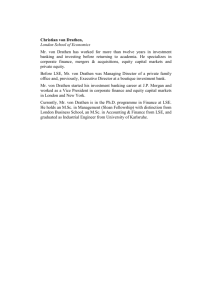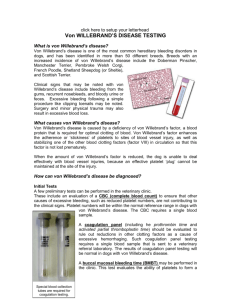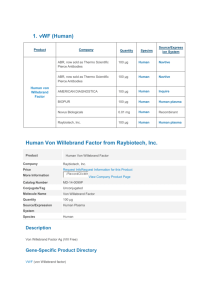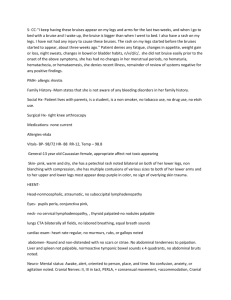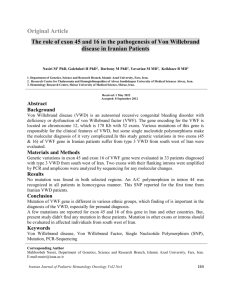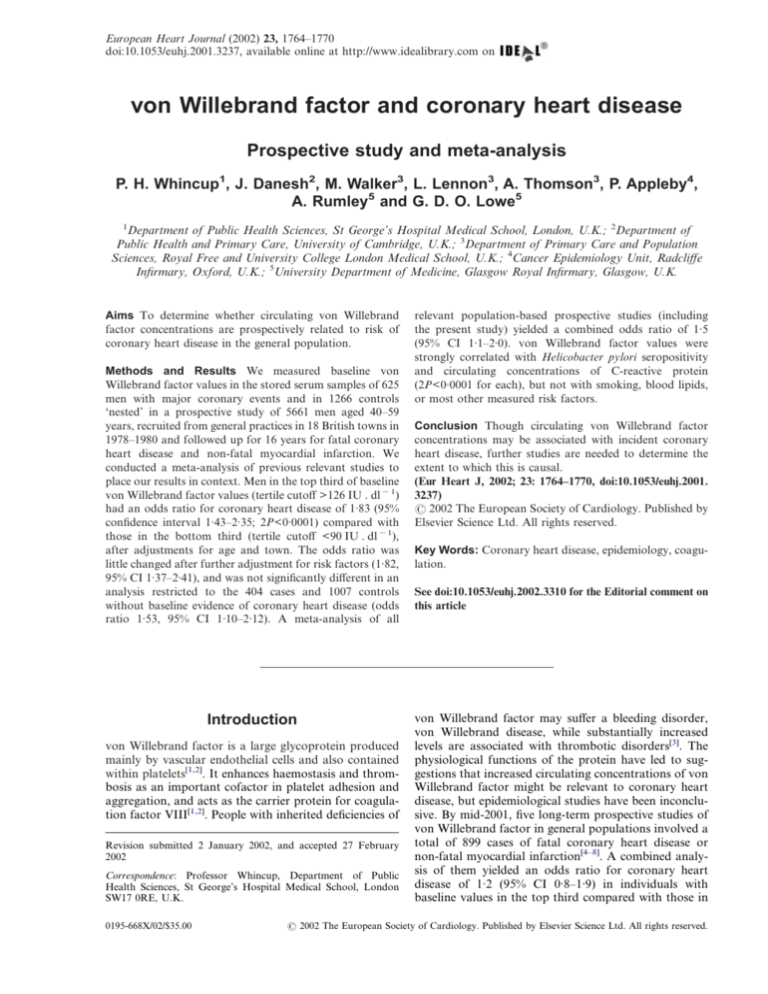
European Heart Journal (2002) 23, 1764–1770
doi:10.1053/euhj.2001.3237, available online at http://www.idealibrary.com on
von Willebrand factor and coronary heart disease
Prospective study and meta-analysis
P. H. Whincup1, J. Danesh2, M. Walker3, L. Lennon3, A. Thomson3, P. Appleby4,
A. Rumley5 and G. D. O. Lowe5
1
Department of Public Health Sciences, St George’s Hospital Medical School, London, U.K.; 2Department of
Public Health and Primary Care, University of Cambridge, U.K.; 3Department of Primary Care and Population
Sciences, Royal Free and University College London Medical School, U.K.; 4Cancer Epidemiology Unit, Radcliffe
Infirmary, Oxford, U.K.; 5University Department of Medicine, Glasgow Royal Infirmary, Glasgow, U.K.
Aims To determine whether circulating von Willebrand
factor concentrations are prospectively related to risk of
coronary heart disease in the general population.
Methods and Results We measured baseline von
Willebrand factor values in the stored serum samples of 625
men with major coronary events and in 1266 controls
‘nested’ in a prospective study of 5661 men aged 40–59
years, recruited from general practices in 18 British towns in
1978–1980 and followed up for 16 years for fatal coronary
heart disease and non-fatal myocardial infarction. We
conducted a meta-analysis of previous relevant studies to
place our results in context. Men in the top third of baseline
von Willebrand factor values (tertile cutoff >126 IU . dl 1)
had an odds ratio for coronary heart disease of 1·83 (95%
confidence interval 1·43–2·35; 2P<0·0001) compared with
those in the bottom third (tertile cutoff <90 IU . dl 1),
after adjustments for age and town. The odds ratio was
little changed after further adjustment for risk factors (1·82,
95% CI 1·37–2·41), and was not significantly different in an
analysis restricted to the 404 cases and 1007 controls
without baseline evidence of coronary heart disease (odds
ratio 1·53, 95% CI 1·10–2·12). A meta-analysis of all
Introduction
von Willebrand factor is a large glycoprotein produced
mainly by vascular endothelial cells and also contained
within platelets[1,2]. It enhances haemostasis and thrombosis as an important cofactor in platelet adhesion and
aggregation, and acts as the carrier protein for coagulation factor VIII[1,2]. People with inherited deficiencies of
Revision submitted 2 January 2002, and accepted 27 February
2002
Correspondence: Professor Whincup, Department of Public
Health Sciences, St George’s Hospital Medical School, London
SW17 0RE, U.K.
0195-668X/02/$35.00
relevant population-based prospective studies (including
the present study) yielded a combined odds ratio of 1·5
(95% CI 1·1–2·0). von Willebrand factor values were
strongly correlated with Helicobacter pylori seropositivity
and circulating concentrations of C-reactive protein
(2P<0·0001 for each), but not with smoking, blood lipids,
or most other measured risk factors.
Conclusion Though circulating von Willebrand factor
concentrations may be associated with incident coronary
heart disease, further studies are needed to determine the
extent to which this is causal.
(Eur Heart J, 2002; 23: 1764–1770, doi:10.1053/euhj.2001.
3237)
2002 The European Society of Cardiology. Published by
Elsevier Science Ltd. All rights reserved.
Key Words: Coronary heart disease, epidemiology, coagulation.
See doi:10.1053/euhj.2002.3310 for the Editorial comment on
this article
von Willebrand factor may suffer a bleeding disorder,
von Willebrand disease, while substantially increased
levels are associated with thrombotic disorders[3]. The
physiological functions of the protein have led to suggestions that increased circulating concentrations of von
Willebrand factor might be relevant to coronary heart
disease, but epidemiological studies have been inconclusive. By mid-2001, five long-term prospective studies of
von Willebrand factor in general populations involved a
total of 899 cases of fatal coronary heart disease or
non-fatal myocardial infarction[4–8]. A combined analysis of them yielded an odds ratio for coronary heart
disease of 1·2 (95% CI 0·8–1·9) in individuals with
baseline values in the top third compared with those in
2002 The European Society of Cardiology. Published by Elsevier Science Ltd. All rights reserved.
von Willebrand factor and CHD
1765
Figure 1 Prospective studies of von Willebrand factor and coronary heart
disease published before mid-2001. Risk ratios compare top and bottom thirds
of baseline measurements. Black squares indicate the risk ratio in each study,
with the square size proportional to the number of cases and the horizontal
lines representing 99% confidence intervals.
, no adjustment reported for
possible confounders; +, adjustment for age and sex only; + + for these plus
smoking; + + +, for these plus some other classical vascular risk factors.
—
the bottom third of the population (Fig. 1). Even
collectively, therefore, available studies cannot reliably
confirm or refute a 50% excess coronary heart disease
risk. To help clarify the association, we report the largest
and most prolonged prospective study thus far of circulating von Willebrand factor values and coronary heart
disease, with a meta-analysis of previous relevant studies
to place our findings in context.
Methods
In 1978–1980, 7735 males aged 40–59 were randomly
selected from general practice registers in each of 24
British towns and invited to take part in the British
Regional Heart Study (response rate 78%). Nurses
administered questionnaires, made physical measurements, recorded an ECG and collected non-fasting
venous blood samples; in 5661 men in 18 of the towns,
serum was stored at 20 C for subsequent analysis[9].
All men have been monitored subsequently for all-cause
mortality and for cardiovascular morbidity, with a follow up loss of <1% to date[10]. Fatal cases were ascertained through National Health Service Central
Registers on the basis of a death certificate with ICD-9
codes 410-414; the diagnosis of non-fatal myocardial
infarction was based on reports from general practitioners, supplemented by regular reviews of general
practice records, and diagnosed in accordance with
World Health Organisation criteria[11]. We conducted a
nested case-control study based on all 643 coronary
heart disease cases (279 coronary heart disease deaths
and 364 cases of non-fatal myocardial infarction) occurring between 1978 and 1996 (comprising cases reported
in two previous studies[12,13]), and a total of 1278
controls ‘frequency matched’ to cases on town of
residence and age in 5-year bands was randomly selected
from among men who had survived to the end of the
study period free from incident coronary heart disease.
Serum samples were available for 625 of these cases
and 1266 controls for von Willebrand factor measurements to be carried out during the year 2000. The
validity of von Willebrand factor measurement in frozen
samples stored for up to ten years has previously been
reported[6,14].
Laboratory workers, who were blind to the casecontrol status of participants, measured serum concentrations of von Willebrand factor using an enzyme
immunoassay, as in a previous study[6]. Serum concentrations of IgG antibodies to Helicobacter pylori and
Chlamydia pneumoniae were measured with a commercial ELISA method[13] and by time-resolved fluorimetry
using the whole organism respectively[15]. C reactive
protein and serum amyloid A concentrations were determined by sensitive enzyme immunoassays[16] and homocysteine measured using a modified automated reverse
phase HPLC method[17]. To provide comparison with
previous studies which had measured von Willebrand
factor in plasma, we assayed von Willebrand factor in
paired plasma and serum samples from 56 healthy
individuals. Close agreement was observed between
plasma and serum values in these individuals (correlation coefficient=0·94), as in an earlier report[18]. Because of fluctuations of von Willebrand factor values
within individuals over time, case-control comparisons
of measured baseline values tend to underestimate any
association with coronary heart disease risk[19–21], von
Willebrand factor measurements were therefore made in
pairs of samples collected at an interval of 5 years
apart in 1009 controls in a separate study[5], yielding a
self-correlation coefficient of 0·63 (GDO Lowe et al.,
unpublished data). These data were used to estimate the
magnitude of regression dilution and to allow for it, by
providing adjusted estimates of the mean values for
the thirds of the von Willebrand factor distribution,
but without altering the odds ratios (see Results)[20,21].
Eur Heart J, Vol. 23, issue 22, November 2002
1766
P. H. Whincup et al.
Table 1 Baseline characteristics of men with coronary heart disease and of age- and
town-matched male controls. Values indicate meanstandard deviation or numbers
(%) unless otherwise indicated
Cases
(n=625)
Controls
(n=1266)
P value
Questionnaire
Age (years)
Current smoker
Evidence of coronary disease*
Treated diabetic
>2 drinks alcohol/day
Non-manual occupation
Homeowner**
52·65·3
333 (52)
230 (36)
18 (3)
128 (20)
143 (22)
344 (63)
52·55·3
540 (42)
259 (20)
21 (2)
288 (23)
355 (28)
823 (69)
matched
<0·0001
<0·00001
0·09
0·18
0·009
0·02
Physical measurements
Body mass index (kg . m 2)
Systolic blood pressure (mmHg)
Diastolic blood pressure (mmHg)
FEV1 (l . min 1)
26·03·4
15222
8614
30872
25·43·3
14621
8313
32378
0·0006
<0·00001
<0·00001
<0·00001
Blood sample
Total cholesterol (mmol . l 1)
HDL cholesterol (mmol . l 1)
Triglyceride (mmol . l 1)
von Willebrand factor (IU . dl 1)
6·621·07
1·090·48
2·251·32
12143
6·190·99
1·160·29
1·951·18
11344
<0·00001
<0·00001
<0·00001
0·0003
Characteristic
*Evidence of ischaemia on baseline electrocardiogram or reported history of angina or myocardial
infarction.
**Information on home ownership was available for only 548 cases and 1200 controls.
We pre-specified case-control analyses by thirds of
von Willebrand factor values in controls, involving unmatched stratified logistic regression fitted by
unconditional maximum likelihood (STATA Corporation). For associations between von Willebrand factor
and a variety of known and suspected risk factors,
emphasis was mainly given to differences more extreme
than 2·6 SD (2P]0·01) to make some allowance for
multiple comparisons. Using methods previously
described, a meta-analysis was conducted of available
prospective studies of von Willebrand factor and coronary heart disease published before mid-2001 with
greater than 1 year of follow-up[21]. Cases were compared only with controls within the same study to avoid
potential biases. To minimize biases further, previous
studies of approximately general population samples[4–8]
were considered separately from studies of cohorts
defined on the basis of pre-existing vascular
disease[22–29]. Several smaller studies could not be
included because they did not report separately on
non-fatal myocardial infarction or coronary heart disease death, but in total they involved fewer than 10% of
the cases included in the present meta-analysis[30–36].
Results
There were highly significant differences between cases
and controls with respect to various known vascular risk
factors and von Willebrand factor (Table 1). Baseline
von Willebrand factor values in the control population were highly significantly associated with age
(P<0·00001), H. pylori seropositivity, C-reactive protein
Eur Heart J, Vol. 23, issue 22, November 2002
concentration, and globulin (P<0·001 for each), even
after adjustments, whereas the association between von
Willebrand factor and smoking became non-significant
after adjustment (Table 2). No strong associations were
observed of von Willebrand factor values with a variety
of other classical and suspected risk factors, including
blood glucose concentration (Table 2), nor with crude
markers of renal function or indicators of childhood
socioeconomic status (data not shown). In a comparison
of men in the top third compared with those in the
bottom third of baseline von Willebrand factor values
(tertile cutoffs, >126 vs <90 IU . dl 1), the odds ratio
for coronary heart disease was 1·83 (95% CI 1·43–2·35;
2P<0·0001) after adjustments for age and town
(Table 3). The mean observed von Willebrand factor
values in the top and bottom thirds were 164 and
76 IU . dl 1; the corresponding mean usual von
Willebrand factor values in these groups (after adjustment for within-individual variation) were 140 and
80 IU . dl 1[20]. The odds ratio was little changed after
further adjustment for smoking and other risk factors
(1·82, 1·37–2·41), and was not significantly different in
an analysis restricted to the 404 cases and 1007 controls
without baseline evidence of coronary heart disease
(1·53, 1·10–2·12; 21 =0·6; P>0·1). The findings were
unaffected by varying the pre-specified cut-off level of
von Willebrand factor for analysis.
Discussion
The present community based study is larger (625
vs 348 cases) and more prolonged (16 vs 5 years of
von Willebrand factor and CHD
1767
Table 2 Comparisons of the levels of risk factors and other characteristics by thirds of von Willebrand factor values
in controls. Values indicate meanstandard deviation or numbers (%) unless otherwise indicated
Numbers
Classical risk factors
Age (years)
Current smoker
Total cholesterol (mmol . l 1)
HDL cholesterol (mmol . l 1)
Triglyceride (mmol . l 1)
Body mass index (kg . m 2)
Systolic blood pressure (mmHg)
Diastolic blood pressure (mmHg)
>2 drinks alcohol/day
FEV1 (l)
Evidence of CHD at entry
Markers of infection or inflammation
Helicobacter pylori seropositivity
Chlamydia pneumoniae titres (FC106)
Log10 C-reactive protein (mg . l 1)
Log10 serum amyloid A protein (mg . l 1)
White cell count (109 . l 1)
Albumin (g . l 1)
Globulin (g . l 1)
Other suspected risk factors
Homocysteine (mol . l 1)
Haematocrit (%)
Insulin (mU . l 1)
Glucose (mmol . l 1)
Socioeconomic factors
Non-manual occupation
Homeowner
Married
Car owner
High
>126 IU . dl 1
430
Middle
90–126 IU . dl 1
415
Low
<90 IU . dl 1
421
t+
t+ +
53·35·1
199 (46)
6·171·00
1·170·32
1·901·18
25·43·6
15022
8413
112 (26)
30978
95 (22)
52·75·0
179 (43)
6·211·07
1·150·27
1·931·18
25·23·3
14520
8113
74 (18)
32477
83 (20)
51·35·5
157 (37)
6·210·91
1·150·26
2·031·21
25·62·9
14620
8314
97 (23)
33774
79 (19)
6·2
2·6
0·2
0·4
1·4
1·1
2·0
0·2
0·5
2·8
0·3
5·3****
1·6
0·5
0·1
1·6
0·2
3·0*
1·0
0·0
1·7
0·6
286 (81)
185·861·7
0·270·53
0·860·33
7·31·8
44·12·6
29·73·3
235 (72)
180·855·7
0·130·54
0·840·30
7·21·7
44·42·4
28·92·9
214 (64)
176·262·4
0·040·50
0·820·27
7·11·8
45·02·3
28·63·0
4·3
1·5
4·5
1·6
1·6
3·7
5·9
3·4**
1·1
3·3**
1·3
0·3
2·5
4·9****
1612
42·69·6
1718
5·631·26
159
42·39·1
1617
5·661·61
134
42·29·1
1714
5·581·19
2·3
0·5
0·4
0·4
1·6
0·7
0·8
0·6
105 (24)
247 (63)
387 (90)
284 (72)
116 (28)
265 (68)
363 (87)
290 (74)
130 (31)
303 (75)
371 (88)
339 (84)
0·9
3·1
0·6
3·4
0·6
2·7*
0·7
3·1*
+t tests derived from regression of von Willebrand factor values on each characteristic separately adjusting for age and town only.
+ +t tests derived from regression of von Willebrand factor values adjusting for age, town, smoking, body mass index, and markers of
socioeconomic status (including height).
Adjustments for social class were omitted in the regressions involving markers of socioeconomic status.*P<0·01, **P<0·001,
****P<0·00001. FC=fluorescent count.
follow-up) than the previous largest study of circulating
von Willebrand factor concentrations and subsequent
coronary heart disease[4]. It suggests that even after
adjustment for baseline values of classical risk factors,
a moderately strong association persists between von
Willebrand factor and coronary heart disease. Despite
the approximately 20 year period of sample storage
before measurement, the validity of our von Willebrand
factor values is supported by the consistency with previous results, by their expected increase with age and by
the similarity of results from the Caerphilly Study using
the same assay method[6,14].
Meta-analysis of previous prospective studies
Five previous prospective studies of von Willebrand
factor in approximately general populations have involved a total of 899 coronary heart disease cases and
18 552 controls, with a mean weighted age at entry of 56
and mean weighted follow-up of 7 years[4–8] (Fig. 1). All
but one[8] used enzyme-linked immunoassays (the validity of the immunoassay in serum, as used in the present
study, was confirmed by our own comparative study —
see Methods). All previous studies reported adjustment
for smoking and other classical coronary risk factors,
and there was no significant heterogeneity among their
separate results (24 =3·3; P>0·1). A combined analysis
of them yielded an odds ratio of 1·2 (95% CI 0·8–1·9) in
individuals with baseline von Willebrand factor values in
the top third compared with those in the bottom third.
Although this combined odds ratio is somewhat less
extreme than the odds ratio in the present study of 1·8
(95% CI 1·4–2·4: Fig. 2), it is only marginally significantly different (21 =4·8; P=0·03) as the present study
may have somewhat overestimated (and previous studies
somewhat underestimated) the true risk due to the play
of chance: a combined analysis of them should provide a
more reliable estimate.
Overall, the studies involved 1524 coronary heart
disease cases and 19 830 controls, yielding a combined
Eur Heart J, Vol. 23, issue 22, November 2002
1768
P. H. Whincup et al.
Table 3 Odds of coronary heart disease in men who had values of von Willebrand factor in the top third of the
distribution of controls relative to those who had values in the bottom third of this distribution
Odds ratio (95% CI) adjusted for:
vWF values
(IU . dl 1)
Cases
Controls
Age and
town only
Age, town and
smoking
Age, town,
smoking and risk factors*
Age, town,
smoking, risk factors and SES**
1·83 (1·43–2·35)
1·53 (1·19–1·98)
1·00
1·78 (1·39–2·29)
1·49 (1·16–1·93)
1·00
1·85 (1·42–2·41)
1·54 (1·18–2·02)
1·00
1·82 (1·37–2·41)
1·51 (1·13–2·01)
1·00
404 cases and 1007 controls without baseline evidence of coronary heart disease
>126
159
334
1·55 (1·16–2·09) 1·52 (1·13–2·04)
1·59 (1·17–2·18)
90 to 126
137
332
1·32 (0·98–1·78) 1·25 (0·93–1·70)
1·30 (0·95–1·79)
<90
108
341
1·00
1·00
1·00
1·53 (1·10–2·12)
1·29 (0·92–1·80)
1·00
All 625 cases and 1266 controls
>126
267
430
90 to 126
214
415
<90
144
421
SES=socioeconomic status.
*Blood pressure, total cholesterol, HDL cholesterol, triglycerides, body mass index.
**Information on occupation, housing tenure, marital status, and car ownership and childhood socioeconomic factors(i.e. father’s social
class, family car ownership, bathroom in house, hot water tap in house, bedroom sharing, and height).
odds ratio of 1·5 (95% CI 1·1–2·0). Eight other published
prospective studies of von Willebrand factor in cohorts
defined on the basis of previous disease (including
diabetes[22], peripheral vascular disease[23], angina[24],
and previous myocardial infarction[25–29]) have included
an additional 723 coronary heart disease cases and 5720
controls. They give a similar combined odds ratio for
coronary heart disease of 1·6 (1·0–2·5), but, again, the
confidence interval is wide (Fig. 2).
Biological relevance of associations
The relevance of von Willebrand factor coronary heart
disease remains uncertain. As well as having roles
in haemostasis and thrombosis[1,2], circulating von
Willebrand factor values can increase markedly during
acute phase responses to systemic and/or local inflammation and to endothelial injury[1,2,37,38]. Thus, it might
be that von Willebrand factor is a marker of systemic
inflammatory processes (such as chronic infection)[39], or
Figure 2 Prospective studies of von Willebrand factor
and coronary heart disease including the present study.
Risk ratios compare top and bottom thirds of baseline
measurements. Black squares indicate the risk ratio in
each study, with the square size proportional to the
number of cases and the horizontal lines representing 95%
confidence intervals.
Eur Heart J, Vol. 23, issue 22, November 2002
a marker of factors that might produce local endothelial
damage (such as elevated circulating concentrations of
homocysteine)[40], or just a marker of the extent of
subclinical atherosclerosis (which is partly ‘inflammatory’)[41]. To help distinguish between these possibilities,
we related serum von Willebrand factor values to serological evidence of chronic infection with C. pneumoniae
and H. pylori, circulating concentrations of several acute
phase reactants and of homocysteine, and several other
known or suspected vascular risk factors in 1266 controls. Baseline von Willebrand factor concentrations
were strongly correlated with circulating values of
C-reactive protein and globulin and, perhaps, with low
serum albumin (all three of which are indicators of
systemic inflammation[19]), but not with baseline evidence of coronary heart disease. Although we observed
a significant association between von Willebrand factor
values and H. pylori seropositivity (a chronic gastric
infection weakly associated with coronary heart disease
in previous studies[42]), a previous placebo-controlled
randomized trial of H. pylori eradication treatment
involving a few hundred patients with non-ulcer dyspepsia[43] found no significant difference in von
Willebrand factor values 1 year after randomization
(G. D. O. Lowe, K McColl et al., unpublished data),
suggesting that any influence of H. pylori infection on
von Willebrand factor levels is not rapidly reversible. It
has recently been suggested, on the basis of a small
non-randomized trial[44], that aspirin use may lower
circulating concentrations of von Willebrand factor.
However, in the Caerphilly Study, von Willebrand
factor levels were not related to the use of aspirin or of
other prescribed medication[14]. In the present study, the
prevalence of aspirin use was not recorded at entry but
as its regular use in the general population in the late
1970s was relatively uncommon, it is unlikely that
aspirin use could materially influence the association
between von Willebrand factor and coronary heart
disease.
von Willebrand factor and CHD
Conclusions
The present study, together with a synthesis of previous
relevant studies, suggests the existence of an association
between von Willebrand factor levels and risk of future
coronary heart disease. Further studies are needed to
determine whether this association is causal.
Professor A. G. Shaper established the British Regional Heart
Study, which is a British Heart Foundation Research Group and
also receives support from the Department of Health. K. Craig, F.
Key, and L. Oxford provided von Willebrand factor assays; M. B.
Pepys and J. R. Gallimore provided C-reactive protein and serum
amyloid A assays; H. Refsum and P. Ueland provided homocysteine assays; M. Thomas, Yuk-ki Wong and M. Ward provided
C. pneumoniae serology; J. Atherton and C. Hawkey provided
H. pylori serology; and J. John provided valuable assistance. J.D.
was supported by the Raymond and Beverly Sackler Award in the
Medical Sciences. A.R. and G.D.O.L. are supported by project and
programme grants from the British Heart Foundation. The views
expressed here are those of the authors and not necessarily those of
the Departments of Health.
References
[1] Mannucci PM. von Willebrand factor: a marker of endothelial
damage? Arterioscler Thromb Vasc Biol 1998; 18: 1359–62.
[2] Lowe GDO. Haemostatic risk factors for arterial and venous
thrombosis. In: Poller L, Ludlam CA, eds. Recent advances in
blood coagulation. Edinburgh: Churchill Livingstone, 1997:
69–96.
[3] Fosang AJ, Smith PJ. To clot or not. Nature 2001; 413: 475–6.
[4] Folsom AR, Wu K, Rosamond WD, Sharret AR, Chambless
LE. Prospective study of hemostatic factors and incidence
of coronary heart disease: the Atherosclerosis Risk in
Communities (ARIC) Study. Circulation 1997; 96: 1102–8.
[5] Smith FB, Lee AJ, Fowkes FGR, Rumley A, Lowe GDO.
Hemostatic factors as predictors of ischemic heart disease and
stroke in the Edinburgh Artery Study. Arterioscler Thromb
Vasc Biol 1997; 17: 3321–5.
[6] Rumley A, Lowe GDO, Sweetnam PM, Yarnell JWG, Ford
RP. Factor VIII, von Willebrand factor and the risk of major
ischaemic heart disease in the Caerphilly Heart Study. Br J
Haematol 1999; 105: 110–16.
[7] Thogersen AM, Jannson J-H, Boman K et al. High plasminogen activator inhibitor and tissue plasminogen activator levels
in plasma precede a first acute myocardial infarction in both
men and women: evidence for the fibrinolytic system as an
independent primary risk factor. Circulation 1998; 98: 2241–7.
[8] Meade TW, Cooper JA, Stirling Y, Howarth DJ, Ruddock V,
Miller GJ. Factor VIII, ABO blood group and the incidence
of ischaemic heart disease. Br J Haematol 1994; 88: 601–7.
[9] Shaper AG, Pocock SJ, Walker M, Cohen NM, Wale CJ,
Thomson AG. British Regional Heart Study: cardiovascular
risk factors in middle-aged men in 24 towns. BMJ 1981; 283:
179–86.
[10] Walker M, Shaper AG, Lennon L, Whincup PH. Twenty year
follow-up of a cohort based in general practice in 24 British
towns. J Publ Health Med 2000; 22: 479–85.
[11] Tunstall-Pedoe H, Kuulasmaa K, Amouyel P, Arveiler D,
Rajakangas AM, Pajak A. Myocardial infarction and coronary deaths in the World Health Organization MONICA
Project. Circulation 1994; 90: 583–612.
[12] Whincup PH, Mendall MA, Perry IJ, Strachan DP, Walker
M. Prospective relations between Helicobacter pylori infection, coronary heart disease, and stroke in middle-aged men.
Heart 1996; 75: 568–72.
[13] Whincup PH, Danesh J, Walker M et al. Prospective study
of virulent strains of Helicobacter pylori and coronary
heart disease in late middle-aged men. Circulation 2000; 101:
1647–52.
1769
[14] Yarnell JW, Sweetnam PM, Rumley A, Lowe GD. Lifestyle
and hemostatic risk factors for ischemic heart disease: the
Caerphilly Study. Arterioscler Thromb Vasc Biol 2000; 20:
271–9.
[15] Wong Y-K, Sueur JM, Fall CHD, Orfila J, Ward ME. The
species specificity of the micro-immunofluorescence antibody
test and comparisons with a time resolved fluoroscopic
immunoassay for measuring antibodies against Chlamydia
pneumoniae. J Clin Pathol 1999; 2: 99–103.
[16] Danesh J, Muir J, Wong Y-K, Ward M, Gallimore R, Pepys
MB. Risk factors for coronary heart disease and acute-phase
proteins: population-based study. Eur Heart J 1999; 20:
954–9.
[17] Refsum H, Ueland PM, Svardal AM. Fully automated fluorescence assay for determining total homocysteine in plasma.
Clin Chem 1989; 35: 1921–7.
[18] Parving H-H. Concentrations of von Willebrand Factor in
diabetes. BMJ 1996; 312: 642.
[19] Danesh J, Whincup PH, Walker M et al. Low grade
inflammation and coronary heart disease: prospective study
and updated meta-analyses. BMJ 2000; 321: 199–204.
[20] Clarke R, Shipley M, Lewington S et al. Underestimation of
risk associations due to regression dilution in long-term
follow-up of prospective studies. Am J Epidemiol 1999; 150:
341–53.
[21] Danesh J, Collins R, Appleby P, Peto R. Fibrinogen,
C-reactive protein, albumin or white cell count: meta-analyses
of prospective studies of coronary heart disease. JAMA 1998;
279: 1477–82.
[22] Saito I, Folsom AR, Brancati FL, Duncan BB, Chambless
LE, McGovern PG. Nontraditional risk factors for coronary
heart disease incidence among persons with diabetes: the
Atherosclerosis Risk in Communities (ARIC) Study. Ann
Intern Med 2000; 133: 81–91.
[23] Smith FB, Rumley A, Lee AJ, Leng GC, Fowkes FGR, Lowe
GDO. Haemostatic factors and prediction of ischaemic heart
disease and stroke in claudicants. Br J Haematol 1998; 100:
758–63.
[24] Thompson SG, Kienast J, Pyke SDM, Haverkate F, Van de
Loo JCW. Hemostatic factors and the risk of myocardial
infarction or sudden death in patients with angina pectoris.
N Engl J Med 1995; 332: 635–41.
[25] Wiman B, Andersson T, Hallqvist J, Reuterwall C,
Ahlbom A, deFaire U. Plasma levels of tissue plasminogen
activator/plasminogen activator inhibitor-1 complex and von
Willebrand factor are significant risk markers for recurrent
myocardial infarction in the Stockholm Heart Epidemiology
Program (SHEEP) Study. Arterioscler Thromb Vasc Biol
2000; 20: 2019–23.
[26] Moss AJ, Goldstein RE, Marder VJ et al. Thrombogenic
factors and recurrent coronary events. Circulation 1999; 99:
2517–22.
[27] Jansson JH, Nilsson TK, Johnson O. von Willebrand factor,
tissue plasminogen activator, and dehydroepiandrosterone
sulphate predict cardiovascular death in a 10 year follow-up of
survivors of acute myocardial infarction. Heart 1998; 80:
334–7.
[28] Jansson JH, Nilsson TK, Johnson O. von Willebrand factor in
plasma: a novel risk factor for recurrent myocardial infarction
and death. Br Heart J 1991; 66: 351–5.
[29] Hamsten A, Walldius G, Szamosi A et al. Plasminogen
activator inhibitor in plasma: risk factor for recurrent
myocardial infarction. Lancet 1987; 2: 3–9.
[30] Jager A, van Hinsbergh VWM, Kostense PJ et al. von
Willebrand factor, C-reactive protein and 5-year mortality in
diabetic and nondiabetic subjects. Arterioscler Thromb Vasc
Biol 1999; 19: 3078.
[31] Standl E, Dahl B, Weichenhain B, Stiegler H, Hormann A,
Holle R. Predictors of 10-year macrovascular and overall
mortality in patients with NIDDM: the Munich General
Practitioner Project. Diabetologia 1996; 39: 1540–5.
[32] Stehouwer CDA, Nauta JJP, Zeldenrust GC, Hackeng
WHL, Donker AJM, den Ottolander GJH. Urinary albumin
Eur Heart J, Vol. 23, issue 22, November 2002
1770
[33]
[34]
[35]
[36]
[37]
P. H. Whincup et al.
excretion, cardiovascular disease and endothelial dysfunction
in non-insulin-dependent diabetes mellitus. Lancet 1992; 340:
319–23.
Blann AD, Miller JP, McCollum CN. von Willebrand factor
and soluble E-selectin in the prediction of cardiovascular
disease progression in hyperlipidaemia. Atherosclerosis 1997;
132: 151–6.
Blann AD, McCollum CN. von Willebrand factor and soluble
thrombomodulin as predictors of adverse events among
subjects with peripheral or coronary atherosclerosis. Blood
Coagul Fibrinolysis 1999; 10: 375–81.
Agewall S, Wikstrand J, Fagerberg B. Prothrombin fragment
1+2 is a risk factor for myocardial infarction in treated
hypertensive men. J Hypertens 1998; 16: 537–41.
Kalaria VG, Zareba W, Moss AJ et al. Gender-related
differences in thrombogenic factors predicting recurrent cardiac events in patient after acute myocardial infarction. The
THROMBO investigators. Am J Cardiol 2000; 85: 1401–8.
Pottinger BE, Read RC, Paleolog EM, Pearson JD. von
Willebrand factor is an acute phase protein in man. Thromb
Res 1989; 53: 389–95.
Eur Heart J, Vol. 23, issue 22, November 2002
[38] Blann AD, Taberner DA. A reliable marker of endothelial cell
dysfunction: does it exist? Br J Haematol 1995; 90: 234–41.
[39] Danesh J, Collins R, Peto R. Chronic infections and coronary
heart disease: is there a link? Lancet 1997; 350: 430–6.
[40] Danesh J, Lewington S. Plasma homocysteine and coronary
heart disease: systematic review of published epidemiological
studies. J Cardiovasc Risk 1998; 5: 229–32.
[41] Ross R. Atherosclerosis-an inflammatory disease. N Engl J
Med 1999; 340: 115–21.
[42] Danesh J, Youngman L, Clark S, Parish S, Peto R, Collins R.
Helicobacter pylori infection and early onset myocardial
infarction: case-control and sibling pairs study. BMJ 1999;
319: 1157–62.
[43] McColl K, Murray L, El-Omar E et al. Symptomatic
benefit from eradicating Helicobacter pylori in patients with
non-ulcer dyspepsia. N Engl J Med 1998; 339: 1869–74.
[44] Pernerstorfer T, Eichler H-G, Stohlawetz P, Speiser W, Jilma
B. Effects of heparin and aspirin on circulating P-selectin,
E-selectin and von Willebrand factor levels in healthy men.
Atherosclerosis 2001; 155: 389–93.

